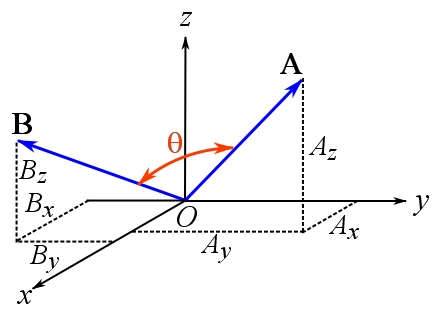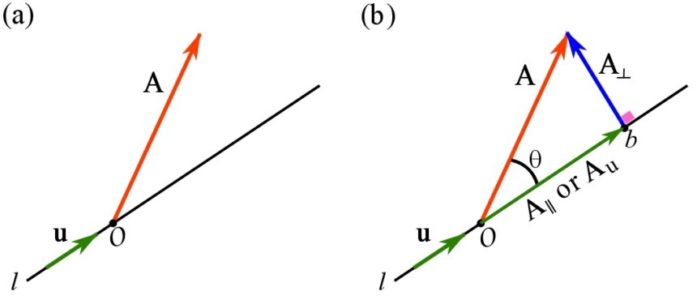Vectors and their Operations: Dot product
The dot product and its properties
The dot product, also called the scalar product, is an operation that takes two vectors and returns a scalar. The dot product of vectors ![]() and
and ![]() , denoted as
, denoted as ![]() and read “
and read “![]() dot
dot ![]() ” is defined as:
” is defined as:
(2.14) ![]()
where ![]() is the angle between the two vectors (Fig. 2.24)
is the angle between the two vectors (Fig. 2.24)

From the definition, it is obvious that the result of the dot product is a scalar. The dot product has three properties as follows:
- Commutativity:

- Associativity (scalar multiplication):

- Distributivity:

The proofs of the first two properties are by direct use of the dot product definition (Eq. 2.14). The proof for the third property is by expanding the right hand side of the equation using CVN and using the properties explained below.
Other properties of the dot product
- Dot product of a vector by itself gives its squared magnitude:
 .
. - Dot product of two perpendicular vectors is zero:
 .
. - Dot product by the zero vector is zero:
 .
.
These properties can be easily proved using Eq. 2.14.
Formulation of the dot product using CVN
Let ![]() and
and ![]() be two vectors with their scalar components
be two vectors with their scalar components ![]() and
and ![]() . Using CVN, we can write:
. Using CVN, we can write:
![Rendered by QuickLaTeX.com \[ \begin{split} \bold A\cdot \bold B&=(A_x\bold i +A_y\bold j+A_z\bold k )\cdot(B_x\bold i +B_y\bold j+B_z\bold k)\\ &\text{by the distributivity property}\\ &=A_xB_x(\bold i\cdot \bold i)+A_xB_y(\bold i\cdot \bold j)+A_xB_z(\bold i\cdot \bold k)\\ &+A_yB_x(\bold j\cdot \bold i)+A_yB_y(\bold j\cdot \bold j)+A_yB_z(\bold j\cdot \bold k)\\ &+A_zB_x(\bold k\cdot \bold i)+A_zB_y(\bold k\cdot \bold j)+A_zB_z(\bold k\cdot \bold k) \end{split}\]](https://engcourses-uofa.ca/wp-content/ql-cache/quicklatex.com-7c33e58afadbb4a263aef97cc9766446_l3.png)
The dot product of the unit vectors, by the dot product properties, are:
![]()
Therefore,
(2.15) ![]()
This result expresses that the dot product of two vectors written in their CVN can be obtained by multiplying their corresponding scalar components and summing over these products algebraically. Equation 2.15 indicates that calculating the dot product (Eq. 2.14) does not need the magnitudes of two vectors and the angle between them, if the vectors are expressed in CVN.
Application of the dot product: finding the angle between two vectors
The dot product can be used to find the angle formed between two vectors or two intersecting lines. This is helpful particularly when solving problems in three dimensions. The angle between two vectors is obtained by solving Eq. 2.14 for the angle term:
(2.16) ![Rendered by QuickLaTeX.com \[\begin{split}\theta&=\cos^{-1}(\frac{\bold A\cdot\bold B}{|\bold A||\bold B|})\quad 0^\circ\le \theta\le 180^\circ\\\bold A&\cdot \bold B=A_xB_x+A_yB_y+A_zB_z \end{split}\]](https://engcourses-uofa.ca/wp-content/ql-cache/quicklatex.com-9374e75df3b65963f3572eab1e169040_l3.png)
The above equation can be manipulated as:
(2.17) ![]()
in which ![]() and
and ![]() are the unit vectors of
are the unit vectors of ![]() and
and ![]() respectively. This result naturally states that the angle between two vectors only depends on their directions and not on their magnitudes.
respectively. This result naturally states that the angle between two vectors only depends on their directions and not on their magnitudes.
Application of the dot product: orthogonal projection of a vector
In many problems, we need to resolve a vector on a particular line or lines in the space. To be more precise, the component of a vector along a particular direction or axis is to be found. Decomposing a vector onto the Cartesian axes is already demonstrated. In this section, we explain decomposing a vector on a general line in space using the dot product. Using the dot product makes the calculation easier specially in three dimensions.
Consider a non-zero vector ![]() in the three dimensional space and a line
in the three dimensional space and a line ![]() intersecting the tail of the vector at a point
intersecting the tail of the vector at a point ![]() (Fig. 2.25a). A unit vector
(Fig. 2.25a). A unit vector ![]() is associated with line
is associated with line ![]() to assign a direction to the line. In other words, The positive direction of the line is determined by
to assign a direction to the line. In other words, The positive direction of the line is determined by ![]() . As demonstrated in Fig. 2.25b, the vector
. As demonstrated in Fig. 2.25b, the vector ![]() can be written as,
can be written as,
(2.18) ![]()
where ![]() is parallel to
is parallel to ![]() , and
, and ![]() is perpendicular to
is perpendicular to ![]() . The symbols
. The symbols ![]() and
and ![]() denote being parallel and perpendicular respectively.
denote being parallel and perpendicular respectively.

The vector ![]() is referred to as the orthogonal projection (or projection) of
is referred to as the orthogonal projection (or projection) of ![]() onto the line
onto the line ![]() or along the direction of
or along the direction of ![]() . We denote
. We denote ![]() as
as ![]() to indicate that
to indicate that ![]() is a projection along the direction of
is a projection along the direction of ![]() .
.
To obtain ![]() , it suffices to note that the vectors
, it suffices to note that the vectors ![]() ,
, ![]() and
and ![]() form a right-angle triangle (Fig. 2.25b). Therefore by the Pythagorean’s theorem
form a right-angle triangle (Fig. 2.25b). Therefore by the Pythagorean’s theorem ![]() . This inspires us to use Eq. 2.14 and write,
. This inspires us to use Eq. 2.14 and write,
(2.19) ![]()
It should be noted that ![]() is the scalar component of
is the scalar component of ![]() resolved along the direction of
resolved along the direction of ![]() . Using the dot product
. Using the dot product ![]() to calculate
to calculate ![]() may result in a negative scalar if the angle between
may result in a negative scalar if the angle between ![]() and
and ![]() are larger than
are larger than ![]() . In such a case, the direction of
. In such a case, the direction of ![]() is in the opposite direction of
is in the opposite direction of ![]() .
.
The following interactive tool illustrates the orthogonal projection of a vector ![]() on the direction defined by a unit vector
on the direction defined by a unit vector ![]() .
.
The perpendicular component of ![]() can be then obtained by writing,
can be then obtained by writing,
(2.20) ![]()
The magnitude of the perpendicular component can be calculated either by ![]() or
or ![]() .
.
In practice, ![]() and
and ![]() can be readily used if
can be readily used if ![]() in known, otherwise
in known, otherwise ![]() ,
, ![]() , and
, and ![]() can be utilized if the components of the vectors in CVN are known.
can be utilized if the components of the vectors in CVN are known.
As a special case, orthogonal projection is used to find the scalar components of a vector, ![]() in a Cartesian frame. This is done by writing:
in a Cartesian frame. This is done by writing:
(2.21) ![Rendered by QuickLaTeX.com \[ \begin{split} A_x&=\bold A\cdot \bold i\\ A_y&=\bold A\cdot \bold j\\ A_z&=\bold A\cdot \bold k \end{split}\]](https://engcourses-uofa.ca/wp-content/ql-cache/quicklatex.com-0ed5b636a18650da2b177a3684e2d2b2_l3.png)
Videos
Dot Product:
Angle Between Vectors:
Orthogonal Projections:
